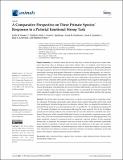Files in this item
A comparative perspective on three primate species’ responses to a pictorial emotional Stroop task
Item metadata
| dc.contributor.author | Hopper, Lydia M. | |
| dc.contributor.author | Allritz, Matthias | |
| dc.contributor.author | Egelkamp, Crystal L. | |
| dc.contributor.author | Huskisson, Sarah M. | |
| dc.contributor.author | Jacobson, Sarah L. | |
| dc.contributor.author | Leinwand, Jesse G. | |
| dc.contributor.author | Ross, Stephen R. | |
| dc.date.accessioned | 2021-03-17T17:30:07Z | |
| dc.date.available | 2021-03-17T17:30:07Z | |
| dc.date.issued | 2021-02-24 | |
| dc.identifier | 273343147 | |
| dc.identifier | 79098dec-f1a4-4723-b682-7ab5744a47ea | |
| dc.identifier | 85101260827 | |
| dc.identifier | 000633224700001 | |
| dc.identifier.citation | Hopper , L M , Allritz , M , Egelkamp , C L , Huskisson , S M , Jacobson , S L , Leinwand , J G & Ross , S R 2021 , ' A comparative perspective on three primate species’ responses to a pictorial emotional Stroop task ' , Animals , vol. 11 , no. 3 , 588 . https://doi.org/10.3390/ani11030588 | en |
| dc.identifier.issn | 2076-2615 | |
| dc.identifier.other | Bibtex: ani11030588 | |
| dc.identifier.uri | https://hdl.handle.net/10023/21650 | |
| dc.description | This study was also supported (in part) by a grant from The David Bohnett Foundation, the Leo S. Guthman Fund, the Chauncey and Marion Deering McCormick Foundation, and, at the time of writing, L.M.H. was supported by the Women’s Board of Lincoln Park Zoo. | en |
| dc.description.abstract | The Stroop effect describes interference in cognitive processing due to competing cognitive demands. Presenting emotionally laden stimuli creates similar Stroop-like effects that result from participants’ attention being drawn to distractor stimuli. Here, we adapted the methods of a pictorial Stroop study for use with chimpanzees (N = 6), gorillas (N = 7), and Japanese macaques (N = 6). We tested all subjects via touchscreens following the same protocol. Ten of the 19 subjects passed pre-test training. Subjects who reached criterion were then tested on a standard color-interference Stroop test, which revealed differential accuracy in the primates’ responses across conditions. Next, to test for an emotional Stroop effect, we presented subjects with photographs that were either positively valenced (a preferred food) or negatively valenced (snakes). In the emotional Stroop task, as predicted, the primates were less accurate in trials which presented emotionally laden stimuli as compared to control trials, but there were differences in the apes’ and monkeys’ response patterns. Furthermore, for both Stroop tests, while we found that subjects’ accuracy rates were reduced by test stimuli, in contrast to previous research, we found no difference across trial types in the subjects’ response latencies across conditions. | |
| dc.format.extent | 22 | |
| dc.format.extent | 1177375 | |
| dc.language.iso | eng | |
| dc.relation.ispartof | Animals | en |
| dc.subject | Affect | en |
| dc.subject | Attentional bias | en |
| dc.subject | Cognitive bias | en |
| dc.subject | Emotions | en |
| dc.subject | Snake detectin theory | en |
| dc.subject | Stroop effect | en |
| dc.subject | Touchscreen | en |
| dc.subject | Welfare | en |
| dc.subject | Zoo | en |
| dc.subject | BF Psychology | en |
| dc.subject | DAS | en |
| dc.subject.lcc | BF | en |
| dc.title | A comparative perspective on three primate species’ responses to a pictorial emotional Stroop task | en |
| dc.type | Journal article | en |
| dc.contributor.institution | University of St Andrews. School of Psychology and Neuroscience | en |
| dc.identifier.doi | 10.3390/ani11030588 | |
| dc.description.status | Peer reviewed | en |
This item appears in the following Collection(s)
Items in the St Andrews Research Repository are protected by copyright, with all rights reserved, unless otherwise indicated.

